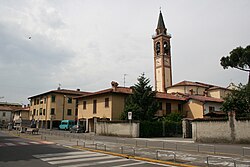Pagazzano
| Pagazzano | |
|---|---|
| Comune | |
| Comune di Pagazzano | |

Centre of the town with church
|
|
| Coordinates: 45°32′N 9°40′E / 45.533°N 9.667°ECoordinates: 45°32′N 9°40′E / 45.533°N 9.667°E | |
| Country | Italy |
| Region | Lombardy |
| Province | Province of Bergamo (BG) |
| Area | |
| • Total | 5.0 km2 (1.9 sq mi) |
| Elevation | 126 m (413 ft) |
| Population (Dec. 2004) | |
| • Total | 1,956 |
| • Density | 390/km2 (1,000/sq mi) |
| Demonym(s) | Pagazzanesi |
| Time zone | CET (UTC+1) |
| • Summer (DST) | CEST (UTC+2) |
| Postal code | 24040 |
| Dialing code | 0363 |
Pagazzano is a comune (municipality) in the Province of Bergamo in the Italian region of Lombardy, located about 40 kilometres (25 mi) east of Milan and about 20 kilometres (12 mi) south of Bergamo based on an agriculture, craftsmanship and mechanics oriented economy. As of 31 December 2011, it had a population of 2,083 and an area of 5.0 square kilometres (1.9 sq mi).
Pagazzano borders the following municipalities: Bariano, Brignano Gera d'Adda, Caravaggio, Morengo.
Pagazzano has always had a connotation of small agricultural settlement, and has been the country's border between the Duchy of Milan and the Republic of Venice.
The moated castle, Castello di Pagazzano, located just south of the town, was built around 1450. It has undergone recent restorations.
With the fall of the Sforza’s dynasty, Pagazzano came under the Spanish rule. The Pagazzano community had to face a period of oppression and misrule that blocked the economic development contributing to its decline. Under Austrian rule in 1700, living conditions improved.
The ancient center of Pagazzano has a great importance in the urban landscape of the village, and it has been maintained the structure that the village had in the Middle Age.
The age range from 36 to 53 years constitute the largest part of the municipal population, counting for 28.5% of the total, followed by the band 18 – 35 years old, which counts 25.1% of the residents.
The industrial development of recent years and the intense building activity, have led to an increase of the inhabitants: comparing the increase in residents with the decrease in the birth rate shows that the increase in population is due to the positive net migration, mainly because of the foreign nationals immigration.
The statistical data on immigration in the municipality showed a preponderance of African immigrants than those from Asian countries and EU citizens. In total about 5% of the population is not Italian.
...
Wikipedia

